|
A GREENLAND CHRONICLE SUMMER 1967
A GREENLAND CHRONICLE SUMMER 1967 |
Bill Simmons' story...
Bill Simmons' story... |
|
|
|
It had its beginnings in the middle of November, 1966. I had just completed a 30 day leave at home in Massachusetts after having served in Korea for 14 months and I had orders in hand to go directly to Europe. While processing through Fort Dix, New Jersey, a certain PFC, about the 5th one in a line of maybe 10 of them at processing desks, asked me how long I had to go in Army and I said, “11 months”. He proceeded to explain to me in all his PFC(Private First Class) professionalism, that “anyone with less than 12 months left to serve didn’t have to go to Europe if they didn’t ‘want to’. (This wasn’t the Army I was used to) He told me to go to a building down the street, which I did and when I got there, I was surprised again. I explained to a woman at the very first desk my situation and she pleasantly asked, “Where would you like to be stationed? “ (Well …golllleeee Gomer, I’m wondering if I’m still in the US Army here). Anyway, the closest she could assign me to ‘home’ was Fort Belvoir, Virginia, so I graciously accepted.
A few days later (and this where it gets REALLY strange) I arrived at Belvoir on a beautiful fall day. It was warm and sunny and bright yellow leaves were just falling off the trees there. I was dressed in Army Class A uniform, carrying a heavy duffel bag and somehow I got from the bus station to the “REPLDEPOT” and reported in. A First Sgt. at the main desk took my orders and proceeded to look up the unit, the USARSG (and now it gets REALLY, REALLY strange) and seemed to have some difficulty. He couldn’t find the unit in the Post Directory so I sat there for a while. He finally kind of gave up and, as it was late in the afternoon, said “we’ll fix it in the morning.”
I spent the night in a barracks populated by re-assigned souls who were probably also in some kind of Army limbo. Colonels, Majors, Captains, Sgt. Majors, First Sgt’s., and here I am a lowly SP5. I actually had a bottom bunk and a Lt Col had the top. Rank didn’t seem to have any meaning in that barracks. A Private and a Major were playing cards on top of a foot locker.
The next morning, I got back to the First Sgt. at the desk, and he greeted me with a “oh, yeah, you again”. He got back to work, sort of, but produced no results. He just couldn’t find this “USARSG” place. It was sometime before noon and I had been in and out of the building a few times and, for no particular reason, I picked up a phone book that was on another desk and guess what was listed with a phone number? Right…USARSG HQ. I show it to the ‘Top’ and somewhat kind of testy, he called the number. His conversation was pretty short, something like, “Where are you guys? Oh. Well I got this replacement here at REPLDEPOT. Simmons. Yer coming to get him? Ok. He’ll be out front.” After exchanging pleasantries I retrieved my gear, went out front and sat on a park bench. It was another beautiful day. It couldn’t have been nicer. I was going to like Virginia. However, it didn’t last long.
About 15 minutes or so went by and out of the corner of my eye I saw an ORANGE Toledo Jeep enter the square (it was a one way street around the square) and it was heading towards my bench but it passed me up and kept going. More or less I pay no attention to it (other than the fact that it was ORANGE ? ) but it came around again and drove by again. The third time it came around it stopped in front of me and the PFC (there seemed to be a lot of PFC’s in the Army) driver leaned over to the passenger side and says “Hey. I’m looking for a Sgt Simmons”. I stand up and now I’m real close to the window and he sees my name tag, realizes this is the guy he’s looking for and says, and I’ll never forget this;
“SO YER GOIN TO GREENLAND TOO?” Good grief!! I AM? (For some reason, at that very moment, I had the thought that Greenland wasn’t very close to Massachusetts)
|
|
My indoctrination into the USARSG was probably the most informal process of my military stint. A round of introductions, brief sketches of the mission, what the unit was, WHY the unit was, and then more introductions. I remember that there were a lot of officers compared to the number of enlisted men and I didn’t get a real good understanding of what was going on and why it was going on for quite some time.
Being the most informal unit I could have imagined, things were really ‘laid back’ there at Belvoir. Most of the guys in the unit had already been to the Top of the World and were preparing to be there again so they were all giving me advice in one form or another. Over a period of 3 months or so, I came to have a grip on what was happening. To highlight a few of the main points, there was a base camp at Thule Air base, an Army camp some 13 miles away on the edge of an ice cap, a ramp road, a Swing, Camp Century and the Trail. Of course, having never been there, I didn’t have a clue, but I would pretty soon.
Being the ‘laid back’ unit it was leave was pretty liberal. I spent Christmas at home and went home on some weekends (it was an 8 hour drive to Massachusetts). Made a bunch of friends there and we all hung out together, even the officers. The Commander, Colonel Arthur Murray was a guy anyone could talk to. He like fast cars and drove a Jag. I had a Honda Super Hawk and he was real interested in that.
The unit was really top heavy with First Sgt’s, and we even had a Sgt Major. We had an Air wing with 2 choppers and a fixed wing Otter. I was in the heavy equipment section and spent most of the days at the ‘motor pool’, doing nothing. All the equipment was actually in Greenland.
One day, a request went out from HQ for someone who could drive a tractor trailer over the civilian roads. I thought that to be a strange request, but when it came down to actually driving in traffic, there was no one there who had any experience except me. I did have a Military License for the combination, and had actually driven one on the highways once so I volunteered.
The next thing I know I’m in a new Army TT unit, taking an orange, fixed wing, (did I say orange again?) De-Havilland Otter strapped to a flatbed trailer to Dover AFB in Delaware. It seemed everything in that unit was orange. An E-7 was with me and we got a lot of looks on that trip. We crossed the Chesapeake Bay on the Bridge, got to Dover and I backed it up to a C-141. The fly guys were real nervous about me not backing into their plane. Hey, I didn’t! The orange Otter was transported to Greenland.
I kept a journal from about this point and starting here those entries will be prefixed by a “JE”. The unit spent Easter Sunday in Virginia and the next day, bussed to Andrews AFB and boarded a C-130. It was a pretty noisy trip.
|
|
(JE 1330 hrs, 14 Jul 1967; Navy crew on the plane. Flying north. 1630 hrs. Having an ‘inflight lunch” not too bad actually. 1830 hrs. Land at Goose Bay. Really windy and cold. We get coffee and hang around in the Terminal building. 2000 hrs. Take off very rough and some guys get sick.)
A C-130 in all its military glory is NOT a Boeing 747. They do not have nice seats or flight attendants. As I recall, the trip took 11 hours. It was also cold. As we flew further north, things looked pretty bleak. Glaciers, mountains, snow, more glaciers and more snow. This was not looking good. Everyone got a blanket. I was impressed. This was the Army I was actually used to. Dress greens, flimsy black shoes, and one blanket, flying towards the North Pole. However, it was not as cold IN the plane, as it was when they opened the rear doors when we landed. Oh my good God……what did I do to deserve this? Welcome to the Top of the World and “LET’S GET INSIDE AS SOON AS POSSIBLE, OK ?
|
|
(JE 0100 / 0200 hrs. 15 Apr. 1967; The sky is light and the ground is white and barren. Really smooth landing. Doors open and Arctic air rushes in. The familiar voice of CWO4 Benny Wilkes greets us with some well chosen obscenities. We get on busses and get deposited at different buildings. I get out at S245 , Thule AFB, room 14. Not exactly a hotel. The building is like a huge freezer box but with the heat on the inside. Double doors, double thick windows, long corridors and washer, dryer and showers. Not bad overall for a military thing. Old timers are cruising the corridor, trying to scare us with “cold” stories. 1000 hrs. Wake up; get to dining hall for a Danish breakfast. Not bad, but not great. Temp outside is 20f. Get to the Base Exchange and look around.)
|
|
The days following were somewhat of a blur, involving cold weather indoctrination, mission statements, receiving arctic gear, the how, what and the why. Initially, I was assigned to work with the N.Y. District Corps of Engineers. I thought it was a pretty decent assignment, as the stories of the trials and tribulations of the “swing” were not sounding very pleasant. For a couple of weeks I did work for and with the DCE as a “loaner” I guess. Then one day, (and somehow I knew it was coming) a Colonel came out to a job site I was on and told me they wanted me back at HQ Army at Thule and that the DCE had to give me back. I knew then that I was destined for the “Swing”.
|
|
Camp Tuto US Army: SP4 Roessler gives us the first ride up there and it was a visual for sure. A military bus (the one we used at Belvoir) of course, a very icy roadway, and very slow going. I saw small (for lack of a better word ) shipping containers, spaced at one mile intervals along the road. I learned that they were survival huts, to be used if your vehicle couldn’t make it any further. (This revelation conjured up some very negative visuals ). I never had to use one. The Army camp was a collection of Army looking buildings, mostly covered half way up to their roofs with snow. I was soon to learn that ANY building that even had a pinhole in it somewhere would have filled up inside to the roof with snow ( very small ice crystals ). This made for a lot of shoveling by some guys, as I remember the Fire Department building completely full, including the fire trucks. Being a heavy equipment operator, I was assigned to moving a lot of snow with the equipment that had been kept in the “Cat House” over the long, sunless winter.
|
(JE 16 Apr 0835; I get my first assignment, it’s a night shift. Have to spend the night at Tuto in the CAT House keeping the equipment running and fueled up and oiled. So I’m back off to Thule. I stop at Hanger 9 to see the guys at AV Branch. They’re putting the Otter together. They have a helicopter to do also. Had to push a guy on a forklift to get it started with my jeep. 1200 hrs. Get some chow and off to get sleep. Have to put cardboard over the windows to block out the light. 1600 hrs; Roessler wakes me up and we’re off to Tuto. I get briefed on the equipment checks. I’m not alone. PFC Turner takes the 1st 3 hours and we’ll split it up from there. 2400 hrs: We fuel up the 100 KW generator and he gets sprayed with fuel. No change of clothes…
|
It took a few weeks of steady work by multiple crews with multiple Cat dozers with very wide blades to move all the snow to acceptable distances away from the buildings. Some buildings were never cleared as The USARSG was not using Camp TUTO as a base camp, but for the very last time, as a staging area for a Camp Century Swing and a survey trip out onto the icecap. We would be bussed from Thule to TUTO and back again every day. A night shift would keep the equipment at TUTO running and the buildings clear of snow and ice that was constantly being re-deposited by the ever blowing winds.
The equipment in the Cat house and other large buildings were being prepared for that trip scheduled to depart on May 1. One of the final details I was on at TUTO was to smooth a wide path next to Ramp Road so that the wanigans and trailers and sleds could be dragged up that path and final provision loading and preparations could be made there.
|
Ramp Road was a 3 mile dirt road that had been made by the Engineers in years past so that just such preparations could be carried out by truck and other wheeled vehicles. It was a Road to nowhere. It started at a corner of Camp TUTO and stretched out onto the ice cap and abruptly ended.
I had been operating a Cat D-9 with a 15 foot wide blade on it and the cab had no center windshield. I was working on this Ramp road access path one day and it was extremely cold.
The icy wind was continually blowing into the cab but I had a full set of Arctic clothing on so I was relatively comfortable, UNTIL I tried to get out of the cab. I found that my knees were locked up from the cold which I hadn’t been aware of. It was a genuine a surprise. No frostbite but a scare for sure. The next time I went out, I had several layers of blankets covering my knees. They finally got a windshield put in that unit and made for a much more comfortable work environment.
|
May 1st. 1967; The Swing was assembled, we all had our assignments and we were ready to go off on a great expedition, more or less. My assignment was a modified Cat D-9, with a blade. (More on the specifics of the equipment later It was pretty strange stuff.) My specific ‘drag’ was 5 cargo trailers with 11 foot tall pneumatic tires, each trailer being about 60 or 70 feet long. Directly behind me was a load of 10 foot long bamboo poles with a black flag attached to each one. It looked like there were a million of them. (More on THAT later). The next trailer was a workshop building. The one following that was loaded with food and the next one was loaded with spare parts and the last one loaded with drums of oil.
The train set up next to me was the fuel unit. It was 3 or 4 sleds, one with an 8,000 gallon fuel tanker (like one from a tractor trailer unit) with diesel fuel. The next sled was a similar 5,000 gallon tanker with Aviation fuel and the next sled had two Army, tracked M113 APC’s mounted side ways, so they could be off loaded from a trench ( dug by me because I had the blade, remember ? ) and it had several Skidoo snowmobiles. Early models, rope pull starters, no wind screens, really primitive stuff
|
The next train was the heart of this whole expedition. It was 4 sleds, with what were called wannigans (I still don’t know why ). A wannigan was a ‘building’, so to speak, on skis. The first one in line behind its tractor was the sleeper about 70 feet long. It had 30ish or more bunks, stacked like on a submarine, 3 high. I had a top bunk with a ‘window’ (a peep hole about 4 by 4 inches with 2 inch thick Plexiglas).
The second unit was ‘command’ with a radio room, command office and a small infirmary. It was about the same length as the sleeper and the third unit was the mess hall, complete with knotty pine trim and all, just like home. The fourth unit was the “power house”, with two 500 KW diesel generators, welding shop, various parts and a lot of steel bar stock. The Power House was little shorter than the other wanigans and overall, the train must have been a couple of hundred feet.
|
There was another train in this group which had a tractor with a crane boom on the back. My assignment was to “double team” any one of these trains up hills as needed. I don’t ever remember having to triple head. These trains were really heavy items.
The tractors were modified Cat D-9s, Turbo charged with a 25 hp gasoline pony engine to start the diesel engine. They had elongated frames, no track rollers but teakwood slides, track pads about 55 inches wide, a 600 gallon nose fuel tank, a 300 gallon belly tank behind the engine, an enclosed operator’s cab, a ladder and a cat walk to get on board, and a 150 gallon rear tank. They could probably do 4 miles an hour when not pulling anything. Most tractors had a very large capacity power winch behind the cab with one inch wire rope. Because my tractor had a blade and no nose tank, it was the designated double header.
|
Sometime around mid morning, with much fanfare from spectators on Ramp Road, May 1st, 1967, I hooked up to the ‘command train’ and we slowly double headed up the ice cap for about 3 or 4 miles. The procedure was to get the train up a hill to a flat area and then the whole swing would stop, I would un- hook and go back for my 5 trailers. A simple procedure, but it took a considerable amount of time. There was no radio contact between or amongst the individual tractors so everything was pre planned or hand signaled. For a significant part of the outbound trip, I actually had a co-worker onboard my unit, and therein lays the story of the bamboo poles. My unit had a 55 gallon drum on the catwalk and it was loaded with those 10 foot poles.
|
The job of my rider was to stand out on that catwalk and take one of those poles and spear it into the snow every 100 feet for the 200 plus miles on the outbound leg. The guys who were performing this grisly task were the 537th Engineer Survey Co. of the 30th Topo Bn. They had no other job on this trip other than to survey the spots designated and to plunk in those bamboo poles. (The temperature was almost always somewhere between 0 and -30f ) They were not a very happy bunch when they found out they had to stand out there in unbelievable conditions for weeks A lot of weeks!
The trail to Camp Century had been traversed countless times over the years and it was essential to our survival that it be marked by this method so we would not stray from it on the way back. By the time we were to complete our mission, the ice cap would be in a state of melting and crevasses would open up and they could swallow a whole train. (More on that one later)
I got back to Ramp Road, hooked up to my train and caught up to the rest of the swing, which was just sitting there on the shimmering ice, waiting for me. It occurred to me that while I was the only one working, everyone else was probably not. (How’d that happen?) Anyway, that was the routine, and we stopped several times on the way to Camp Century to let the survey guys do their thing, or to double head units up a hill.
|
It took several days to get to Camp Century; maybe a week and we had some work to do when we got there. Mostly it was outside stuff because Century had been closed for a few years. The Nuclear Reactor had been shut down, deactivated, pulled out and packaged away back to the states we had to collect stored fuel drums from the site and empty those into a tanker and the crane unit could pick up 4 drums at a time with a proper sling set up. About the second day there, a “phase” condition arose and continued to escalate. We were stalled out on the top of Camp Century for 8 days. Some supplies started to run low, no mail, no beer, no smokes etc. (Sounds like a Country / Western song). The air fleet of USARSG was grounded.
|
Probably about the 5th day of this forced stop, 4 of us decided to see if we could get into some of the “Surface Camp” buildings on top of Century. Just the tops of some of the roofs were visible so going in through a door was not an option. Fire axes would get us in, down through the roofs.
Here we were, four of us, chopping a hole in a roof, wind screaming around us lifting the snow off the surface like a fog. We were able to get a hole large enough to allow someone lower himself down into a room. Bill Ford, the unit medic and I lowered down. The other 2 guys said they saw another roof a little ways away and they took the ax and went to make entry into that building. One of the guys was a kid from Georgia. After a few minutes, Ford and I heard loud banging sounds coming from the darkness and realized that the other 2 were chopping a hole into the same building we were already in.
We instantly understood that this would be a perfect set up to scare the hell out of….well who knows? We ran down to the other end of the room (a big long room, maybe 100 feet) and there were some empty cardboard barrels there and we piled them up under where the chopping was taking place. There were also plenty of C02 fire extinguishers around. ( Do you see it coming yet ? ) We let them chop a human size hole in the roof and right away one of them sticks his head down through the hole. He can’t see anything because it’s so dark and says so. We were probably only 5 feet away from him. He stands up and they are talking to each other about what might be “down there”. The ‘good ole` boy” from Georgia decides he is going to lower himself down, feet first. We let him get about waist deep through the hole before we discharged the fire extinguishers. Now, if you’ve ever heard a C0 2 unit go off, it could sound like anything your imagination could possibly dream up. After the absolutely blood curdling scream, the last thing we heard before we cracked up laughing was “IT’S GOT ME!!!!!!!!!! OH MY GOD IT’S GOT ME!!!!!!
|
After this 8 day storm, aircraft finally arrived, a CH 34 chopper and the fixed wing Otter with skis. They had not only supplies but some civilians came along to see what we were up to. There were also some Air Force brass and some AF nurses along for the ride I guess. I didn’t get to talk with any of them as I remember I was on shift and was doing fuels transfers. They all flew away and were probably happy that they could.
Our normal work schedule was 6 hours on and then 6 off. It was kind of a strange schedule to get used to, but we did. However, during this 8 day storm, that that rigid work schedule was relaxed and we went into a maintenance mode, just keeping everything running and full of fuel and oil. Our lives literally depended on it. Temperatures were 10 to 40 below zero and the winds were sometimes 60 to 70 miles per hour. Visibility was actually zero at times and a “white out” was a common experience.
|
When we left Camp Century, on a northerly course towards the coast, it was for the Topo Company to make survey points along the way. Usually it they did a ”shoot” every five miles or so.
|
These shoots were sometimes coordinated with a normal maintenance, fueling stop or shift change. The usual running routine was for the Command train to lead the way for navigation purposes, with a specific running order for the others trains. Because I had the blade and I was the double header, I was always last in line. Occasionally my task was to sometimes scrape a 4 foot deep trench, about 100 feet long, so the train with the flatbeds with the APCs and Skidoos could drive right off the sides of the sled.
|
There was also a fueling operation protocol which had to be followed because if a driver missed his line up spot in the running order, it was a major project to turn one of theses trains around and get it lined up again. I only missed the spot once and it was a 5 mile circle to get the unit back in line. The issue with this was not only the time, but the fact that the train now had to leave the marked trail and travel into potential unknown crevasse territory. Sometimes there was a mechanical breakdown which led to unscheduled stops so it was important that the running order be kept.
When phase conditions ( real bad weather ) came upon our little expedition ( sometimes they came up quite fast ) and a unit was not in the running order, or was maybe a little behind, visibility became an issue. One particular shift, I don’t recall if I was operating or not, one such phase came up fast and it was the worst kind, a phase 3 which resulted in an instant white out. Well, one of the trains was a little behind on the trail, and the “standing order” was when visibility was zero, stop! Everything came to a stop and heads were counted and …ooops… One train and crew missing. No one actually knew how far back they might have been when they stopped so it became an immediate concern because we never knew how long we’d be stopped or how long the storm would blow.
The Swing commander and another guy got a length of rope (about 200 feet), tied it to the rear of the power house sled and went out searching on foot. They made what they thought were arcs starting at the 200 foot distance and shortened the rope up every so often. After a half hour out they came back. They looked like something out of a Hollywood movie. No crew. Two more guys went out on a longer rope and as I remember it, they found the stopped train within an hour and brought the crew back. Makes for a good story but the results could have easily been different for reasons beyond our control for sure.
|
We plodded along across the ice cap with different situations cropping up frequently for what seemed like forever. Time was nothing to us. The sun was up 24 hours a day. You’d pull your shift for 6 hours, jump off, hit the mess hall for a meal (didn’t know if it was midnight or noon) (and actually didn’t care anymore ) and then go get some sleep for maybe 4 hours. Get up, maybe shower, (that was an ordeal) hit the mess hall for another meal and then get in the cab or if we were stopped for a breakdown or maintenance, do whatever we had to do.
The shower ordeal went like this. There was a regular bathroom, so to speak, in the sleeper wannigan. On the outside of this room was a flop down door which covered a compartment into which the one who wanted to take a shower shoveled a sufficient amount of snow. The compartment had under it an oil burner, which, when you fired it up, melted the snow, thus heating the water and you could then shower. Of course this could all take some time. That’s if the oil burner worked, and if it didn’t, well….. Getting 8 hours of sleep in any given 24 hour period was not something that happened with any regularity. That would happen only when storms had us stopped for a period of time.
|
The radio communication link between Camp Tuto or Thule and us out on the ice cap was very irregular. It all had to do with the existing technology, the weather conditions and sun spots (or so it was said). Early in June, we were getting very broken up reports of military action and fighting by the Army and the Air Force attacking and so forth. Again, when trying to communicate with someone over a radio in those conditions and only getting every 3rd word, (If that) we didn’t have a clue as to what was really going on. It was some time, as I recall, maybe a day or so, before we actually knew it was the 67 Israeli war that was going on. We were really concerned until we actually had some hard information, so one can just imagine the anxiety level that existed.
|
Life on the Swing went on. During the ‘double heading’ operations, which were relatively frequent, it had occurred to me that if I could devise a way to unhook from ‘command’ without stopping, we could save some time (purely selfish engineering). Sometimes after un- hooking, the command train could not restart again by itself, which necessitated hooking back up and double heading again until a flat enough area was reached so a tractor could get going by itself.
The loop end of my winch cable had a small length of loose cable after the clamps. I thought that if we increased the length of that small tail, so it would contact the ice, it might generate enough ‘drag’ to unhook itself from the inverted hook under the frame of the towed train. Hot damn, it actually worked. ! With a series of hand signals, I was able to decelerate, observe if command was powering along by itself, let the cable drag, let it detach and then I would accelerate out of the way and make a turn and keep going . Of course, the first time this happened, Swing commanders saw me go by and realized they hadn’t stopped, and were quite amazed that they could keep going. Of course, this now lent to considerable thinking into how far they should continue before they stopped. I still had to go back, hook up and then catch up to them. So it became a ‘time/distance’ thing and if the detachment worked, they would determine how far and how long they would continue. It also depended on the weather conditions. Any visibility issue became a limiting factor.
|
One shift I was working I was running parallel to the command train, about 50 feet off to their right. I couldn’t get anyone’s attention to bring me a coffee so I left my cab, ran across the ice and jumped onboard the mess hall wanigan. No one thought anything about me being there for a few minutes until someone asked if I was on duty….. I could see my unit out the window, chugging right along in place, so I remember saying that “I was” and “I’m just stopping in for coffee”. I took my coffee and went back to my unit. It generated some laughs and a warning. (Go figure).
|
Days went by, shifts went by, 6 on, 6 off and we just kept slowly moving, towards what I didn’t have any idea. The goal was to get a specific point somewhere on the northwest coast of Greenland, airlift the surveyors to an island so they could do a ‘shoot’ and then start the return trip. I think the dreariness and the sameness of the everyday routine just had me in a state that I either didn’t want to know or just didn’t know what that goal was at the time. It must have been like being on the ocean, the same blue sky, the same white ice, all the time The mission, ( as I found out ) was to get to a point near Inglefield Bay so the Topo guys could be airlifted to Harwood Island
|
|
- 32 -->
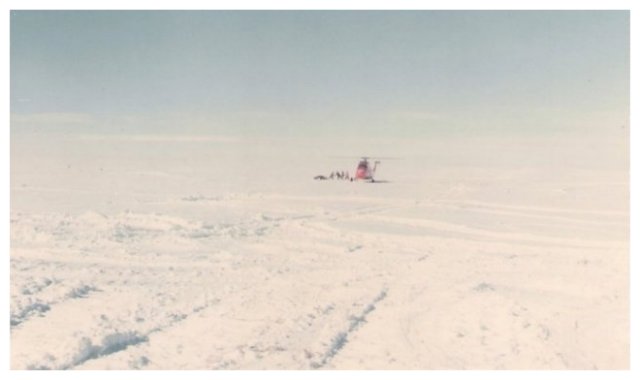
|
Get there we finally did and the Swing stopped about a quarter mile from the coast line. Two choppers showed up sometime later and took the topo guys off to do their thing. Having some time off (so to speak) 4 or 5 of us decided we were going to trudge up to the edge of the cliffs, just to say we had been there. The weather was good, no phase conditions present and we could see a long way and it looked like nothing was going to blow up on us, so off we went. About half way up the hill I realized that I forgotten my camera but there was no going back now.
When we got up to the top, we could see the island way out there, may 5 miles or so, I don’t really know for sure, the ocean was frozen and it looked like you could have walked right out to the island. We weren’t there very long, maybe 5 minutes, when about half way between us and the island, the ice heaved up real slow and a black ‘thing’ stuck up through. It was a submarine. Of course we were absolutely stunned, no one had binoculars or cameras. We didn’t see anyone (it was pretty far away) and couldn’t see anything on the sail. I think we stayed 15 minutes or so and it was still there when we left. When the choppers came back, air crews reported it had been a Soviet Sub. They must have known we were there all the time. I can’t imagine that the Soviet Navy was spying on us “US Army grunts”.
|
I don’t actually remember how long we stayed there on the coast but it couldn’t have been more than a day or two and then we made the big wide turn and headed back, following those flags. The topo guys were real happy for two reasons, one, we were going back and two, they didn’t have to spike any more flags. It was soon after that all the topo guys were airlifted out and it was just the USARSG personnel left on board. I guess there may have been about 10 or15 of us, maybe less. Shortly after the return trip started, Swing commanders elevated me to Shift Commander when I was on duty. That meant 2 things. I changed operating assignments (now I was operating command train) AND, I was supposed to pay attention the running order and who was where and so forth.
Only one incident occurred while I was on duty, which I may have been able to prevent, but thinking about it all later, I guess I couldn’t have prevented it from happening, just could have kept it from escalating to the point that it did get to.
|
All these D9 tractors had a set of running flags mounted high up in the front of the Cats, on the nose tanks or the radiator frames. Anyone could see who was where from the cab of a unit or from inside command itself if visibility was blocked either by a train or blowing ground snow. We were happily motoring along at our usual 1 to 2 miles per hour and there were 2 trains to my left and one to my right. I could directly see 2 units and since the 3rd train was running just a little behind, all I could see were his flags. He was running in that position because that particular tractor had a minor clutch problem which caused the unit to drift to the left. The operator had to just nudge the right clutch handle every 10 minutes or so to keep it in line.
We didn’t want any operator to become distracted and drift into another train so that was ALWAYS that unit’s position. Outside left. Well…..you guessed it. The operator fell asleep. I was reading a book and didn’t look up or at him for some time I guess. When I finally did become aware that he wasn’t in position, I signaled for a stop and went out and looked and there was the smoke trail of his exhaust, going over the horizon. We manually un-loaded 2 Skidoo’s and they chased after him and caught him a mile or so away, waaaayyyyy of the trail. I didn’t read any more books that trip. And he had a co-driver assigned to him. Bad boy….sleeping at the wheel.
Because of the severe cold, metal became really brittle. Thus, there were frequent failures of metal parts. Steel draw bar pins and parts that one human could barely lift, broke with some regularity. Members of our crew were mechanics and welders and they were kept busy almost at every stop. Winches and cables needed repairs all the time and welding was going on regularly.
One disaster was averted by sheer luck. We kept religiously to the flagged trail on the way back and we were always looking out for new crevasses, which were very hard to see because they would sometimes open up and then blowing snow and ice would cover them up with a drift it became just a shadow. We encountered one such hidden trap sometime in late June. Motoring along one shift, the front of the command/infirmary sled fell into a crevasse and brought the command train to a sudden, violent halt. The sled was actually the 3rd unit in the train, 1st being the tractor, 2nd being the sleeper and then the command wannigan.
The front skis of the sled (which were about 3 feet wide and 10 or 12 feet long, had failed to cross the crevasse and went down. The wannigan was tipped down probably 20 or30 degrees and wedged pretty tightly into the side of the ice wall. It took us nearly 2 days to get it out and conduct repairs and get back underway. A nifty bit of engineering and thought went into its recovery even though it was a relatively straight forward job, it was just complicated by extreme cold, snow and ice. We filled in the crevasse with snow and ice with the bladed Cat, positioned 2 Cats back to back on either side of the casualty, connected the winches to each other, reeled in the cables, raised it up, filled in underneath it and pulled the whole train backwards off the danger zone. It wasn’t as easy as it sounds, but that’s the way it went.
|
During the late June melt, when we stopped, you could hear the ice cap breaking and moving. Sometimes it sounded like a railroad train off in the distance. Other times it was just a sharp, loud, BANG ! I never actually felt anything move and I suppose that was a good thing.
|
Strange phenomena occurred on the way back. At some point on the trail, the flags seemed to be getting shorter and shorter. When first speared into the snow, they stuck out maybe 8 or 9 feet. Now we were encountering flags that had 3 or 4 feet showing, and then sometimes just the flag was sticking out of the snow. It was explained to me that with the constantly blowing wind, anything on the surface of the ice cap would be covered up and eventually disappear. Actually, we did have stretches of the trail on which the flags were not visible at all. We had to stop, send out M-116’s or Skidoo’s to locate the actual trail. This operation could take a little time, depending on how many flags were ‘missing’.
Arriving at Camp Century again, we picked up the remaining fuel drums and proceeded towards “home”. We all were VERY happy to be so close, and knew we had less than a week to go. It was great. Phone calls to home would be coming soon, real long hot showers, long sleep times, a PX, warm barracks. What could possibly go wrong? What a dumb thought!
|
We were about 7 miles out from TUTO. We had established good radio communications now (probably because it was mostly down hill to the coast, TUTO and Thule). The trail flags were spotty, but they were still visible, and then, the wind whipped off the ice cap and caught us. Phase conditions escalated slowly and soon intermittent "white outs" had us stopped. The temperature dropped and conditions became absolutely horrific. Some supplies had been allowed to run low because we were so close. Food stores were low, but not a real issue. Cables and draw bars broke. Murphy’s Law was rampaging. We’d move a little, and then stop. And when I say a ‘little’ I mean maybe a hundred feet. It was like there was a puppet master pulling the strings…we could see, move, then something would happen.
TUTO Command actually sent out a search party because we had over estimated our position and thought we were right near Ramp Road. The search party became lost. We radioed them to just STOP. (They were in several Nodwell tracked vehicles) If you looked up, you could see the sun through the blowing snow. If you looked down to your feet, you couldn’t see them. A break in the wind and someone caught sight of the Nodwell’s. They were so close you could have hit them with a snowball (well, almost). We sent out a rescue party on ropes and rescued our rescuers. They were all officers as I recall, and real happy to see us.
This went on for 3 days. 7 Miles in 3 days. At some point, the wind finally stopped blowing. We actually got to the end of Ramp Road and most of us had been awake during this whole episode. I remember that the ‘real’ Army came back into control just then and they were insisting that we keep working and “spot” the trains and the equipment right then and there. Just like nothing had happened. There was some talk of mutiny, running away and other foolishness but cooler heads prevailed and they let the Swing Crew go back to Thule. I don’t remember the bus ride. I do remember getting a hot shower and then someone banging on my room door and saying I had been asleep for 24 hours and it was time to get up. I didn’t think it was time to get up, but I did.
A couple of days later we went back up to ramp road, pulled everything up onto the road, and brought some stuff back down to TUTO and Thule. (I guess the real Army couldn’t do it) During the next few days, a few of us were sent up to the wannigans to seal them up and leave them to their fate. It was sometime in July, 1967.
I went back up for the final time, alone in a jeep, a few days after it was all done. I might have been the last guy there, from the RSG anyway. I parked the jeep maybe a 100 feet from the closest wanigan and shut it off. I became aware right away that the wind was still. Dead calm. As I walked away from the jeep, I could hear air bubbles gurgling in the jeep’s radiator. Another sound caught my attention. It sounded like hammering. I looked around. I knew that there were only 3 or 4 guys back at Tuto, 3 miles away but the sound wasn’t coming from there.
I climbed up onto the outside cat walk ladder and then up to the roof of the first wanigan. The hammering was crystal clear. Someone was pounding nails. I looked towards its direction and could actually see Thule from my vantage point, maybe 10 miles away. The sound was actually coming from Thule and then, it stopped. It was incredibly quiet. I had never heard such silence before. The sound in my ears was deafening and I became conscious of intentionally making noises to drown it out. Scraping my footsteps on the gravel road as I walked back to the jeep, I started it and was comforted by the noise it was making. I think I sat there for a few minutes, knowing that what I was looking at would probably soon be covered over by blowing snow and ice, buried, with maybe just a patch of roof showing through here and there, telling some future visitor that there was once something here. I knew at that moment that I would not be back, turned the jeep around and left the wannigans, to the ages.
William Simmons Easthampton, Massachusetts
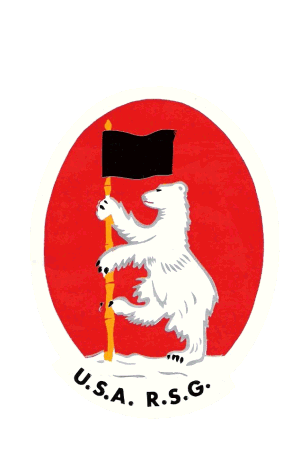
|
|
<
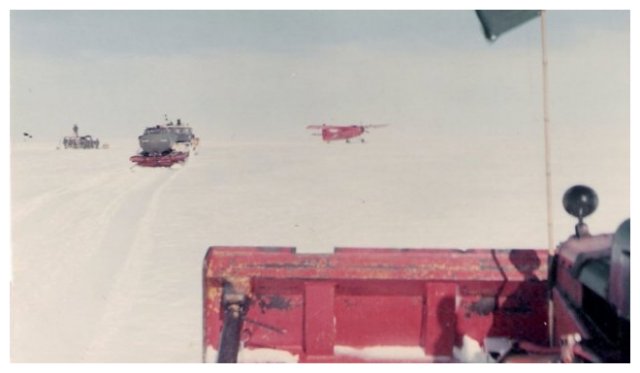
|
|
<
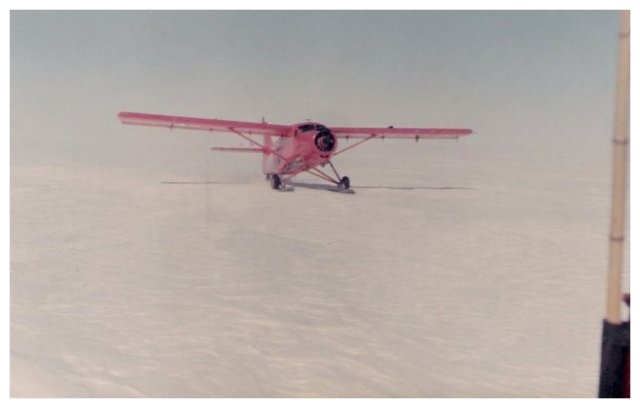
|
|
<
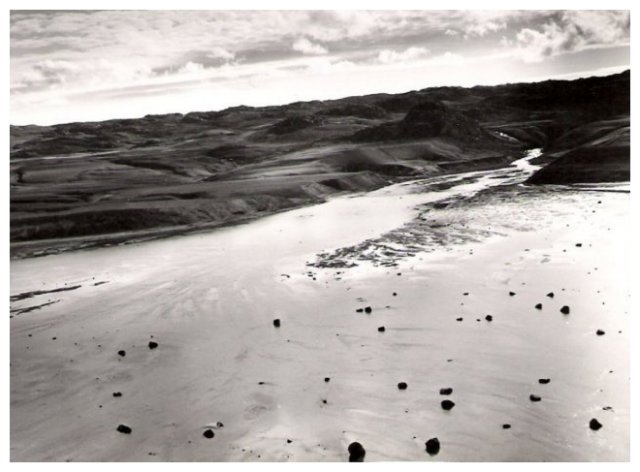
|
|
<
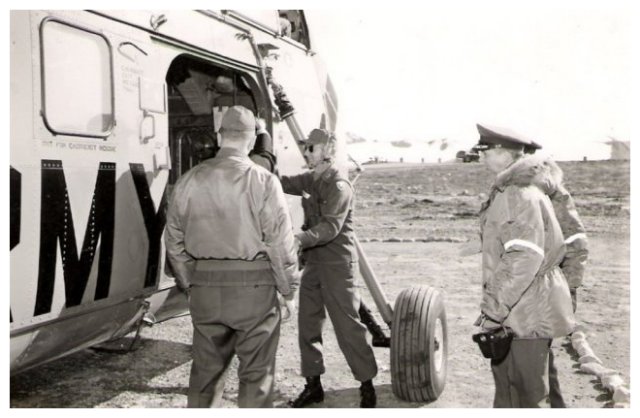
|
|
<
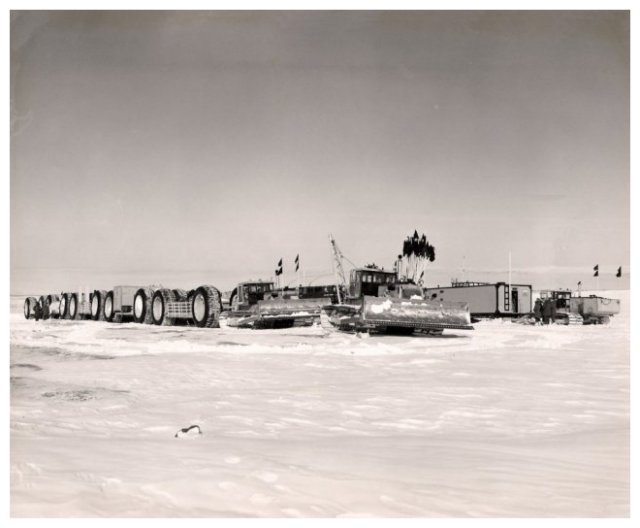
|
|
<
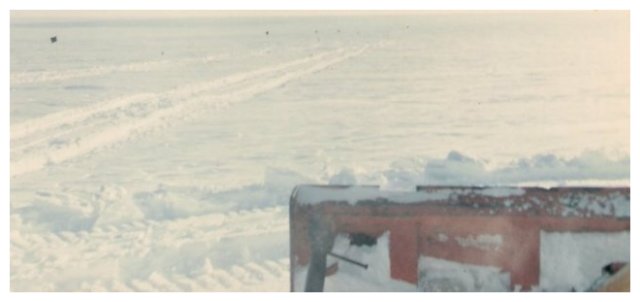
|
Updated at maj 27, 2017
|
© Copyright: By Steffen Winther. Owner of the Thuleforum — All rights reserved. December, 3rd, 1996 - .
|
|